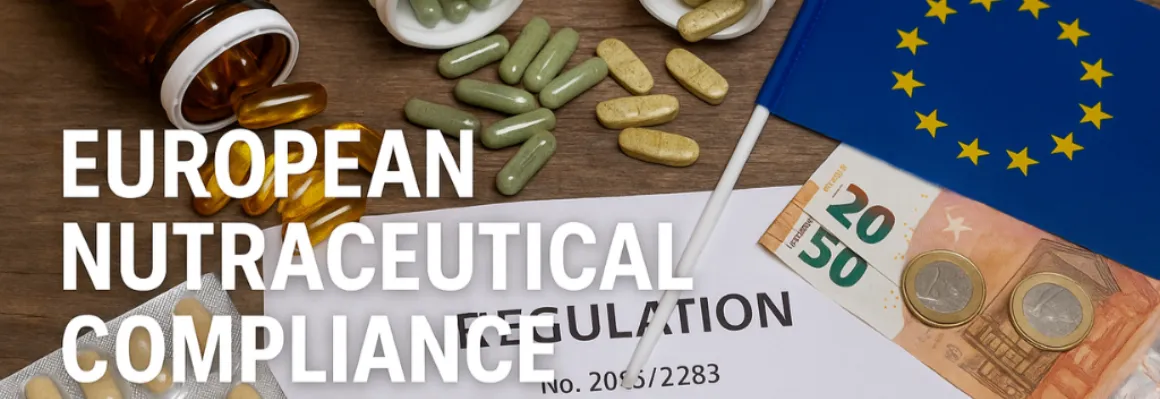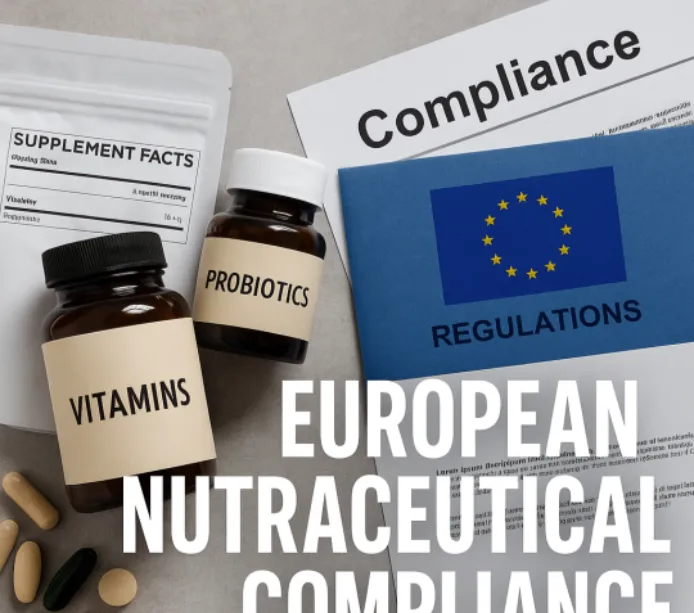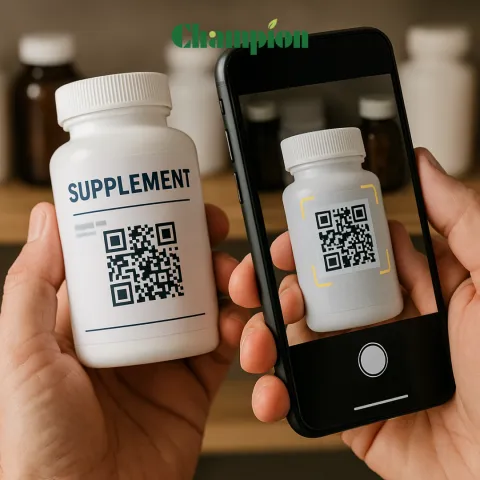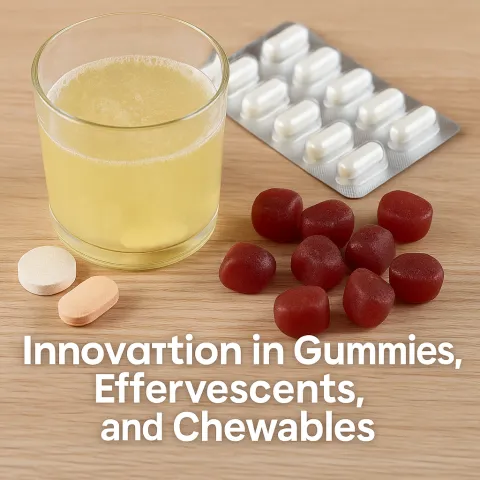Blog
28.Oct.2025
Penetrating the European Nutraceutical Market: Key Pitfalls

Introduction
Europe’s nutraceutical market, projected to exceed $141 billion in 2025, is one of the world’s most lucrative—and most regulated—destinations for supplement brands. With cultural preferences, strict laws, and EFSA enforcement, missteps can lead to costly delays, market refusals, and legal risk. This guide uncovers the main compliance challenges, the evolving regulatory landscape, and essential strategies for brands eyeing sustainable EU growth.The Regulatory Landscape: Who’s in Charge (and What’s Changing)
- EFSA (European Food Safety Authority) is the central gatekeeper for supplement ingredients, safety, and health claims approval across the EU.
- European Commission & DG SANTE set harmonization directives but allow each country to add its own flavor to enforcement (notably in Germany, France, Italy, Spain).
- Recent years have brought:
- Major changes in health/probiotic/botanical claim enforcement.nutraingredients
- Tighter requirements for “novel foods/ingredients” (EC 2015/2283), demanding scientific dossiers and EFSA approval for new actives, rare botanicals, and new extraction processes.
- Moves towards clearer labeling (especially for botanicals, vitamins, and “free-from” claims).
- Continued differences in maximum ingredient levels and registration/notification processes at member state level, despite “harmonization” promises.


Key Compliance Pitfalls (and How to Avoid Them)
1. Health Claim Roulette: Hard to Win Without Data
- The EU operates a "closed list" system: Only EFSA-approved, scientifically substantiated claims are allowed on labels and marketing. All other claims—even if true—are illegal.
- Botanicals and “on-hold” claims: Many health claims for botanicals and probiotics are in legal limbo, with the European Parliament urging EFSA to speed up evaluations and blacklist ambiguous claims in 2025.
- Pitfall: Using U.S.-style “structure-function” claims, testimonials, or creative health statements is usually banned, risking legal action and product removal.
- Strategy: Build your launch plan around claims that are already on the EFSA register—or invest in robust clinical studies and expert legal review to pursue new ones.
2. Novel Foods: New Ingredients, New Headaches
- “Novel” ingredients (not consumed in the EU before May 1997 or new extracts/processes) require an EFSA novel food dossier and can take 18–36 months and €80,000+ in fees.
- Delays and legal bottlenecks are common—2025 sees more brands proactively contesting EFSA decisions and investing heavily in regulatory consultancy.
- Pitfall: Attempting to launch a U.S.-proven ingredient (e.g., new adaptogens, mushroom extracts, synthetic actives) without EU-market history or “novel food” approval.
- Strategy: Plan new ingredient launches years ahead and always check local lists for market history.
3. Labeling and Ingredient Limits: Not Really Harmonized
- Ingredient forms, maximum/minimum levels, and even permitted additives differ by country—vitamin B6 has a max of 0.9 mg in Germany but 12.5 mg in France.food.
- Banned/restricted ingredients vary: e.g., some amino acid chelates allowed in the U.S. are not recognized in EU lists.
- Pitfall: Using a “template” label from another country or mass-producing across the EU with a one-size-fits-all label—risks recalls or border blockages.
- Strategy: Customize formulations, labeling, and documentation for each target EU country.
4. Registration, Notification, and Local Adaptation
- Most products require notification (sometimes full registration) in every country sold; timelines, fees, and required documentation vary.
- Countries like Poland, Italy, and Ireland are stricter on QC/testing and will spot-check imports.
- Pitfall: Assuming that pan-EU “notification” covers you everywhere or neglecting translation/local address requirements.
- Strategy: Work with local regulatory experts, translation/legal partners, and inspect every notification system individually.
5. Compliance Gaps in Manufacturing & Supply Chain
- Good Manufacturing Practice (GMP) is expected but not always harmonized (distinct from pharma GMP). Evaluators look for proven safety, ingredient traceability, and formal risk controls.
- Pitfall: U.S. or Asian suppliers who lack full EU-compliant documentation for every batch, or foreign manufacturers using restricted solvents/processes.
- Strategy: Audit and pre-qualify all vendors for EU-grade traceability, QC, and batch documentation; prefer EU-based contract/OEM partners where possible.
Cultural Adaptation—The “Soft” Barrier That Kills Brands
- European shoppers expect science, transparency, and authority—not just “natural” or influencer-backed buzz.
- Trust in pharmacies, health stores, and professional endorsement is high; trends win only with visible proof and professional opinion.
- Diversity in local tastes and supplement routines: Mediterranean diets, German/Scandi focus on herbal wellness, UK “free-from” demand, French appreciation for botanicals.
- Tailored content, local testimonials, and language/cultural adaptation in packaging/marketing are critical.
Market Entry Checklist for Supplement Brands
| Step | Importance |
| Ingredient assessment | Check for “novel food” risk, positive/negative lists |
| Health claim substantiation | Confirm EFSA register for every planned claim |
| Label customization | Adapt for country-specific limits, language, warnings |
| Notification/registration | Notify in each market with local documents |
| Manufacturing audit | Ensure supply chain traceability, EU safety standards |
| Cultural/retail fit review | Localize branding, influencer/KOL, channel mix |
Winning Tactics for 2025 and Beyond
- Invest in clinical research and work toward EFSA-authorized claims, not just “soft” marketing language.
- Buffer timelines for novel food approval and build market launches around ingredients with established EU histories.
- Use local legal and regulatory partners: Countries have distinctive intake levels, translation, address, or retailer policies.
- Blend science, culture, and trust with pharmacy partnerships, expert endorsements, and third-party testing—build reputational capital, not just trend momentum.
- Monitor and plan for evolving rules: EFSA, the EU Parliament, and national agencies have shown they will litigate, update guidance, and roll back/delay approvals with little notice in 2025.jafconsulting+1
Frequently Asked Questions
Q: Can a U.S.-launched supplement sell “as is” in Europe?A: Almost never. Ingredient, claim, labeling, and notification rules differ widely, and many successful U.S. formulas don’t meet EU standards. Careful reformulation, regulatory adaptation, and robust documentation are required.
Q: How long does novel food approval take in the EU?
A: Plan for 18–36 months minimum, plus potential delays for follow-up data or new scientific questions. Consider staggered launches or using established actives first.
Q: Can brands use health influencer endorsements or customer testimonials on-pack/in ads?
A: Any implied health claim must be on the approved EFSA list; unauthorized health-related statements, even via testimonials or social proof, risk enforcement.
Q: How serious are penalties for non-compliance?
A: Product withdrawals, border rejections, fines, and even legal action are well documented—especially as the regulatory landscape becomes “more litigious” in 2025.
Conclusion
EU nutraceutical compliance is a non-negotiable for growth: It demands data, patience, and deep local insight. Avoid key pitfalls by respecting ingredient and claim rules, customizing for each country, and embracing the scientific and cultural expectations of Europe’s world-class supplement shopper.Ready to enter Europe?
Start with a compliance audit, local expert consultation, and an ingredient review—laying the proper foundation for true, scalable, and profitable market entry.



















